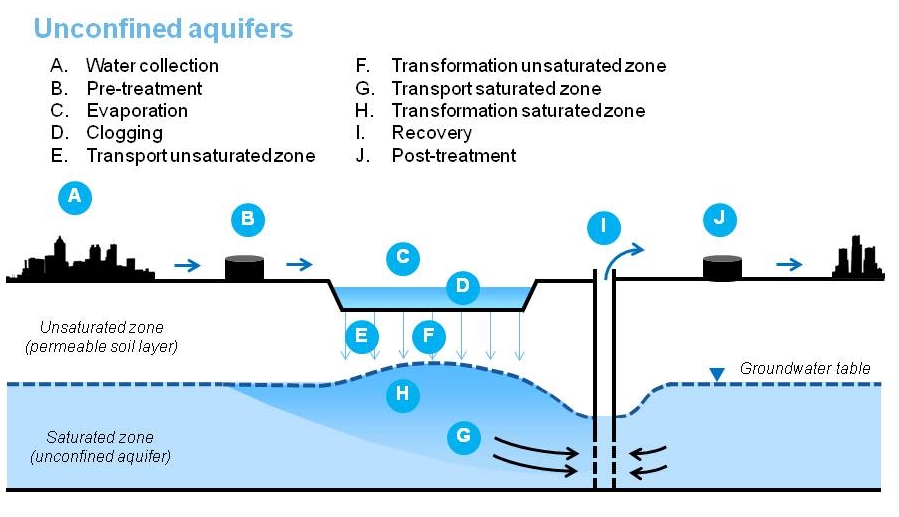The INOWAS platform comprises a variety of analytical and numerical approaches that aid the user in designing and optimizing sustainable MAR schemes by assessing and adjusting operational and design parameters.
Application of MAR does often involve large-scale technical facilities such as injection wells, infiltration ponds and galleries or recharge dams. Building these recharge systems needs careful planning beforehand, in order to achieve field conditions that can be controlled and managed, to reduce construction costs and to understand the local geohydraulic conditions. The planning of these MAR sites can be executed through field and laboratory investigations. However, modeling can be of great advantage for the different stages of the MAR site planning and operation. Preliminary modeling should be undertaken to identify the parameters and processes which have the greatest influence on the local groundwater recharge and thus define the scope of future data collection. Pilot sites and preliminary studies, which are required by some MAR guidelines (Environmental and Water Resources Institute (U.S.), 2001; Natural Resource Management Ministerial Council et al., 2009), can be accompanied by modeling to optimize the MAR site in terms of dimensions, monitoring network and operational parameters. During operation of MAR sites, parameters need to be adjusted to changing conditions, such adjustment of pumping rates at river bank filtrations sites due to changed river levels. Modeling may help with the assessment of operational parameters as different scenarios and parameters sets can be easily implemented and the results of such a scenario analysis may pinpoint to the most feasible parameter set.

The tools of the INOWAS platform provide various approaches with differing complexity for the design and optimization of MAR schemes. Simple analytical approaches may be used to investigate the impact of a defined set of parameters on the aquifer and which influence each parameter has on the results. Complex numerical models can be utilized to study the MAR scheme more thoroughly and focus on specific aspects of the system. A comprehensive guide to operation and design of sustainable surface and subsurface recharge systems has been published by (Bouwer et al., 2008). The design of ASR systems has been described by (Pyne, 2005). Investigations on the feasibility of different recharge techniques were modeled by (Jha and Pfeiffer, 2006) and for in-channel modification the size of the weir was dimensioned. Design of ASR/ASTR well fields and assessment of their operational parameters for have been the focus of many studies (Herrmann, 2006; Pavelic et al., 2006). The optimization and planning of recharge basins often focuses on percolation evolution, groundwater mounding studies and assessment of soil aquifer treatment measures (Kloppmann et al., 2012; Phipps et al., 2007).
The following INOWAS tools can be used to assess operational and design parameters of MAR systems:
- T02. Groundwater mounding calculator
- T03. MODFLOW model setup and editor
- T03b. Solute transport (MT3DMS)
- T07. MODFLOW model scenario manager
- T12. Clogging estimation by MFI-Index
- T13. Travel time through unconfined aquifer
- T18. SAT Basin design
To select a suitable MAR method or a model set for the specific study area, the following tools can be used:
- T04. Database for GIS-based suitability mapping
- T06. MAR method selection
- T11. MAR model selection
- T17. Global MAR portal
REFERENCES
- Bouwer, H., Pyne, R.D.G., Brown, J., St Germain, G., Morris, T.M., Brown, C.J., Dillon, P., Rycus, M.J., 2008. Design, operation, and maintenance for sustainable underground storage facilities. Awwa Research Foundation ;distributed by American Water Works Association ;;distributed by IWA Publishing, Denver Colo. [London].
- Environmental and Water Resources Institute (U.S.) (Ed.), 2001. Standard guidelines for artificial recharge of ground water, ASCE standard. American Society of Civil Engineers, Reston, Va.
- Herrmann, R., 2006. ASR well field optimization in unconfined aquifers in the Middle East, in: UNESCO (Ed.), Recharge Systems for Protecting and Enhancing Groundwater Resources – Proceedings of the 5th International Symposium on Management of Aquifer Recharge ISMAR5, Berlin, Germany, 11–16 June 2005, ISMAR Proceedings. pp. 109–114.
- Jha, M.K., Pfeiffer, O., 2006. Simulation modeling of salient artificial recharge techniques for sustainable groundwater management, in: UNESCO (Ed.), Recharge Systems for Protecting and Enhancing Groundwater Resources – Proceedings of the 5th International Symposium on Management of Aquifer Recharge ISMAR5, Berlin, Germany, 11–16 June 2005, ISMAR Proceedings. pp. 388–394.
- Kloppmann, W., Aharoni, A., Chikurel, H., Dillon, P., Gaus, I., Guttman, J., Kaitzer, T., Kremer, S., Masciopinto, C., Miotliński, K., Pavelic, P., Pettenati, M., Picot-Colbeaux, G., 2012. Use of groundwater models for prediction and optimisation of the behaviour of MAR sites, in: Kazner, C., Wintgens, T., Dillon, P. (Eds.), Water Reclamation Technologies for Safe Managed Aquifer Recharge. IWA Publishing, London.
- Natural Resource Management Ministerial Council, Environment Protection and Heritage Council, National Health and Medical Research Council, 2009. Australian Guidelines for Water Recycling. Managed Aquifer Recharge (No. Document No 24), National Water Quality Management Strategy. Canberra.
- Pavelic, P., Dillon, P.J., Robinson, N., 2006. Modelling of well-field design and operation for an Aquifer Storage Transfer and Recovery (ASTR) trial, in: UNESCO (Ed.), Recharge Systems for Protecting and Enhancing Groundwater Resources – Proceedings of the 5th International Symposium on Management of Aquifer Recharge ISMAR5, Berlin, Germany, 11–16 June 2005, ISMAR Proceedings. pp. 133–138.
- Phipps, D.W., Lyon, S., Hutchinson, A.S., 2007. DEVELOPMENT OF A PERCOLATION DECAY MODEL TO GUIDE FUTURE OPTIMIZATION OF SURFACE WATER RECHARGE BASINS, in: Fox, P. (Ed.), Management of Aquifer Recharge for Sustainability: Proceedings of the 6th International Symposium on Managed Artificial Recharge of Groundwater, ISMAR6, Phoenix, Arizona USA October 28 – Novemeber 2, 2007, ISMAR Proceedings. Acacia Publishing Incorporated, Phoenix Arizona, pp. 433–446.
- Pyne, R.D.G., 2005. Aquifer storage recovery: a guide to groundwater recharge through wells. ASR Systems, Gainesville, Florida.
